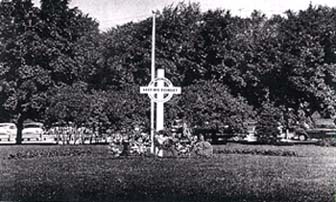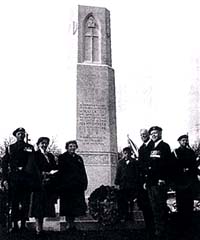
|
|
Waterloo Cenotaph
|

|

Waterloo, Ontario
Constructed in honor of fourteen men of Waterloo who died in World War I (1914-1918).
The Waterloo Cenotaph is located in Waterloo Peace Grove on Regina Street near Laurel Creek
and City Hall. It was re-commissioned on May 26, 1993, after it was moved from Memorial Park
beside Knox Presbyterian Church on Erb Street West. After the World War I, on the Sunday closest to November 11, the citizens of the town of Waterloo remembered their 14 fallen soldiers in various church services. In 1922, it was decided to build a War Memorial in Mount Hope Cemetery, where a soldiers' burial plot had been set aside. On June 18, 1922, the contract was given to Casper Braun, a local mason and monument maker. The granite block bearing a bronze plaque was dedicated by Lieutenant Governor H. Cockshutt with 4,000 citizens in attendance. This memorial was deteriorating in the 1970s and in 1975, Waterloo Legion members erected an angel stone marker, about three feet high with a plaque bearing the inscription "Our Glorious Dead" on the site.
On November 12, 1922, a Twin Cities service of remembrance was held in Lyric Theatre, Kitchener, Ontario. On the previous day, businesses observed a two-minute silence. Work stopped, telephones and telegraph were silent, and no whistles or bells were sounded. The term "Armistice Day" was used after that first Armistice on November 11, 1918, at 11:00 a.m. Between 1923 and 1931, Remembrance Day was merged with the Thanksgiving holiday. After this, the remembrance reverted to November 11, and after World War II, Remembrance Day was the term used in this connection. The custom of observing a two-minute silence was initiated with a recommendation to the British Parliament by Sir James Fitzpatrick a South African statesman, gold miner and farmer and author of Jock of the Bushveldt. The first Poppy Day was held in 1928 in the Twin Cities.
During the 1930s, official Armistice Day ceremonies for Waterloo were still held in Kitchener at its Cenotaph. It is recorded that S.C. Tweed, MLA, sent a wreath to the town to be placed by the mayor of Waterloo at Kitchener's Cenotaph on November 11, 1933. This procedure continued for several years, although Waterloo churches held their own Remembrance Day services on the appropriate Sunday. Older citizens also recall that services involving the children were held at the Central School memorial.
The Civic Park West of the Town Hall, along Erb Street, was created in 1924. About the same time, the Waterloo Horticultural Society proposed the idea of a Memorial Park. The Society suggested planting maple trees, a Canadian symbol, as a remembrance of fallen soldiers. The planting of memorial trees in the park would not only beautify it but would provide a living memorial of the brave Waterloo men who fell in the World War I. In 1925, the beautification of the Civic Park was begun with the financial assistance of the town council. In May 1927, fourteen maple trees were planted as a reminder of the number fallen Waterloo soldiers.
But some people were pushing for a more visible war memorial. The Waterloo Council wanted to dedicate Civic Park as a Memorial Park but no action was taken. The citizens of Waterloo felt differently and a move was made to find a plot of land to dedicate a fitting memorial. On June 15, 1933, Mizpah Lodge #820 of the Salvation Army, and a number of interested citizens marched to a triangular park on the Central School grounds.
Central School, circa 1939, shows Erza Street buildings in the background.
A six-foot-high Wooden Cross was dedicated to the Waterloo boys who gave their lives in the World War I. Three Ministers from St. Andrew's Presbyterian Church (Kitchener), Knox Presbyterian Church (Waterloo), and the Evangelical Church (Waterloo) assisted in the ceremonies.
In 1957, the Waterloo Centennial Year Committee was formed, headed by Legion member, Ronald Hines and Mr. Waterloo Ford S. Kumpf. A fund-raising target of $15,000 was set and the amount was soon raised, enabling work to proceed on the purchase and erection of a 18-foot granite Cenotaph which would replace the wooden cross. The dedication ceremonies were held in the Memorial Park on November 3, 1957.
In 1992, some veterans and others were disturbed when Waterloo City Council was asked if the Waterloo Cenotaph could be moved to allow a parking garage to be built for Marsland Centre. Council agreed to the request. After much debate, the site near the city hall on Regina Street was finally chosen although the old Mueller chimney, erected in 1903, had to be sacrificed. Stu Henderson, president of the 404 Wing, K-W Royal Canadian Air Force Association, said it all for the Legion members when he ended his remarks on Dedication Day with the comment, "May it stay there in perpetuity." The granite Cenotaph was moved to a new site near the Waterloo City Hall in 1993.

Taken from Waterloo Historical Society
Vol. 81 1993

|